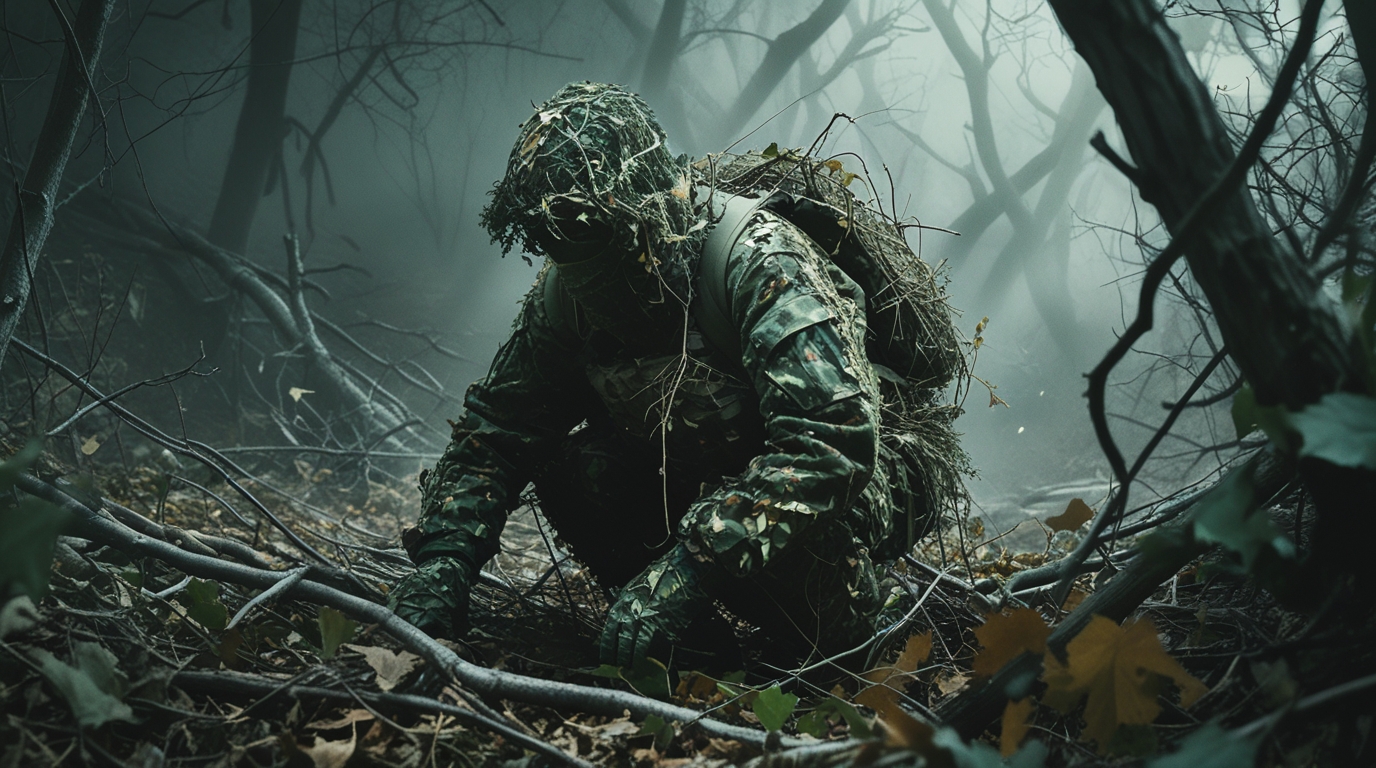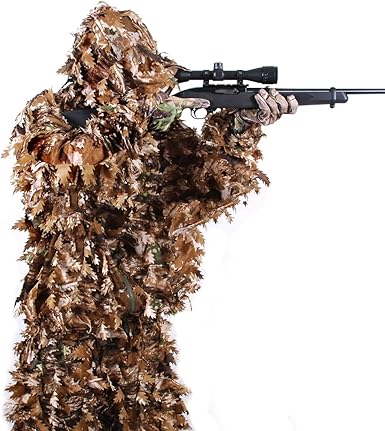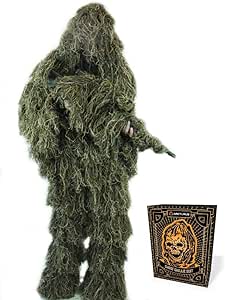Mastering the Art of Camouflage: Expert Strategies for Blending into Any Environment

Mastering the Art of Camouflage: Expert Strategies for Blending into Any Environment
The Principles of Natural Camouflage
Understanding Color and Pattern
Color and pattern are the cornerstones of effective camouflage. The goal is to mimic the colors and patterns found in your environment. For instance, in a forest setting, utilizing greens, browns, and blacks can help you blend with trees and shadows. It’s not just about matching the colors but also breaking up your silhouette with patterns that mimic natural textures, such as leaves or bark. This disrupts the visual cues that predators or enemies use to identify shape and movement.
The Importance of Movement
Movement is often the quickest way to give away your position. In nature, abrupt and fast movements are rare and usually signal the presence of an animal or human. Learning to move slowly and mimic the natural movements of the environment can significantly enhance your camouflage. For example, in windy conditions, moving in sync with the swaying of trees and grass can make you less noticeable.
Light and Shadow
Understanding how light and shadow play within your environment is essential for effective camouflage. Shadows can either be your ally or your downfall. Staying within shadowed areas helps to conceal your presence, but you must also be aware of casting shadows that can reveal your location. The key is to always be conscious of your light source and use it to your advantage, adjusting your position as needed to stay concealed.
Choosing the Right Gear
Camouflage Clothing
Selecting the appropriate camouflage clothing is crucial. There are various patterns available, each designed for specific environments:
- Digital
- Woodland
- Desert
- Snow
Your choice should depend on the predominant colors and textures of the area you’re in. Additionally, the fit of the clothing can impact effectiveness; too loose, and it may catch on vegetation, too tight, and it may restrict movement.
Camouflage Accessories
Beyond clothing, there are numerous accessories that can aid in camouflage:
- Face paints
- Camouflage nets
- Ghillie suits
Each has its application depending on the level of concealment needed and the environment you’re operating in. For instance, a ghillie suit is excellent for stationary observation in dense foliage, while face paint might be sufficient for short-duration hikes in a woodland area.
The Role of Gear Beyond Visual Camouflage
While visual camouflage is vital, it’s also important to consider other aspects such as noise and scent. Gear that minimizes noise during movement and scent-blocking technologies can be just as crucial for staying undetected. This multi-sensory approach to camouflage can greatly enhance your ability to remain hidden in any environment.
The Environment’s Role in Effective Camouflage
Transitioning from gear to environment, it’s clear that your surroundings play a significant role in effective camouflage.
Forest Environments
Forests offer a rich tapestry of colors, shadows, and textures to mimic. The key to blending in is to understand the specific type of forest you’re in-deciduous forests have different camouflage requirements than coniferous forests. Utilizing layered clothing that mimics the forest floor in fall or the greenery in summer can make you nearly invisible.
Desert Environments
Deserts pose their own unique challenges for camouflage. The lack of substantial cover means that color and minimal movement are even more critical. Desert camouflage typically involves light browns, tans, and sometimes a mix of greys to match the sandy and rocky terrain. Covering exposed skin to minimize contrast with the environment and using the terrain’s natural undulations for cover are key strategies.
Urban Environments
Urban environments require a blend of traditional and innovative camouflage techniques. The goal is to mimic the textures and colors of the urban landscape-greys, blacks, and urban patterns can be effective. However, blending in urban settings also means adopting the behavior and movement patterns of people in the area to avoid drawing attention. This dual approach of visual camouflage and behavioral mimicry is essential for effective urban concealment.
Advanced Camouflage Techniques in Specific Scenarios
Blending in Snowy Environments
Snowy environments present a unique challenge due to the overwhelming presence of white and the high reflectivity of snow. To effectively camouflage in such conditions, consider using white camo with slight grey or blue undertones to match the surroundings. Layering is key, as it allows for adjustments based on activity level and temperature. Additionally, minimizing dark shadows is crucial. This can be achieved by staying low to reduce your silhouette and moving during times when shadows are less pronounced, such as cloudy days or within the diffuse light of dawn and dusk.
Adapting to Rainforest Conditions
Rainforests are dense, wet, and filled with a variety of textures and colors. Camouflage in these environments requires gear that can handle moisture while still providing concealment. Opt for patterns with large, dark green and brown blotches to mimic the underbrush and shadowy conditions. Waterproof gear is a must, but it should also be breathable to prevent excessive sweating, which can lead to dehydration and scent trails. Moving quietly and slowly is vital due to the dense foliage, which can amplify sound. Utilize natural paths created by animals to minimize noise and disruption.
The Role of Behavior in Camouflage
Mimicking Natural Habitats
Successful camouflage goes beyond just looking like your surroundings; you must also act like part of the natural habitat. This means observing and mimicking the behavior of local fauna. For example, birds often remain still when sensing danger, so in bird-rich areas, adopting a still, quiet posture can help you blend in. Paying attention to the rhythm and flow of the environment-like the movements of animals and the swaying of plants-can help you move more naturally within it.
The Importance of Silence
Silence is golden in effective camouflage. This includes controlling your breath, minimizing gear noise, and even selecting quiet gear fabrics. Avoid materials that rustle or clank together, and ensure all equipment is securely fastened to prevent accidental sounds. When moving, do so deliberately and slowly to mimic the natural movements of wildlife, reducing the likelihood of drawing attention to yourself.
Camouflage Maintenance and Adaptation
Routine Gear Checks
Regular maintenance of your camouflage gear is essential for sustained effectiveness. This includes repairing any tears or worn areas that might compromise the integrity of the pattern or its ability to blend with the environment. Additionally, washing your gear with scent-free detergent can help eliminate human odors that wildlife or adversaries might detect. It’s also a good opportunity to adjust your camouflage pattern to the changing seasons or environments you anticipate encountering.
Adapting to Environmental Changes
The ability to adapt your camouflage to changing environmental conditions is crucial for remaining undetected. This could mean switching from a green-based pattern in the summer to a brown-based pattern in the fall. It also involves being aware of changes in the environment, such as newly fallen snow or the growth of new foliage, and adjusting your position or camouflage accordingly. Staying informed about weather conditions and seasonal changes can help you anticipate and adapt to the environment more effectively.
Advanced Integration Techniques for Camouflage
Utilizing Natural Materials
To elevate your camouflage game, incorporating natural materials from your immediate environment into your gear can make a significant difference. This means adding branches, leaves, or even mud to your outfit and equipment. Why does this work? Because it directly ties your appearance to the specific textures and colors of your surroundings, making you practically invisible. The key is to regularly update these materials to reflect the current state of the environment, ensuring your camouflage remains effective.
The Art of Stillness
Mastering the art of stillness is crucial for remaining undetected in any environment. This goes beyond simply not moving; it’s about understanding how to slow down your breathing and minimize even the smallest movements that could give you away. For instance, when observing wildlife or waiting in a hideout, practice controlling your breath and limiting muscle movements. This discipline can drastically reduce the chances of detection.
Troubleshooting Common Camouflage Failures
Inadequate Pattern Matching
One of the most common mistakes in camouflage is choosing a pattern that doesn’t quite match the environment. This can lead to standing out rather than blending in. The solution? Always have a variety of patterns available and be ready to adapt your gear as you move through different terrains. Having a base layer that’s neutral and adding specific patterned accessories can offer flexibility and effectiveness.
Overlooking Scent Control
Visual camouflage can be compromised if you neglect scent control. Animals, in particular, have a keen sense of smell and can detect human presence even if they can’t see you. Using scent eliminators and ensuring your gear is washed in scent-free soap can help mitigate this issue, allowing you to remain undetected by both visual and olfactory senses.
Mastering the Art of Camouflage: Final Insights
Continuous Learning and Adaptation
The landscape of effective camouflage is ever-evolving, requiring continuous learning and adaptation. Stay informed about the latest techniques and technologies in camouflage. Attend workshops, follow experts in the field, and practice regularly in different environments to refine your skills. Remember, the effectiveness of camouflage is not just about the gear you wear but how you use the environment to your advantage.
Next Steps for Camouflage Mastery
Embarking on the journey to camouflage mastery involves commitment and creativity. Start by assessing your current gear and identifying any gaps in your camouflage strategy. Experiment with different patterns and materials, and don’t be afraid to customize your gear to better suit your needs. Consider joining a community of like-minded individuals where you can share tips and learn from each other’s experiences. Lastly, always respect the environment you’re operating in, ensuring that your activities promote conservation and sustainability.
In conclusion, effective camouflage is a blend of science, art, and psychology. It requires not only the right gear and techniques but also a deep understanding of the environment and the discipline to remain undetected. By applying the advanced strategies discussed, from integrating natural materials to mastering stillness and troubleshooting common failures, you can elevate your ability to blend into any environment. Whether you’re a wildlife photographer, hunter, or simply someone who loves exploring the great outdoors, mastering the art of camouflage will enrich your experience and enhance your connection with nature.
Essential Ghillie Suits for Maximum Concealment
Now that you’ve grasped the essentials of color and pattern in achieving natural camouflage, it’s time to explore how specific products can elevate your stealth in the wild. The Arcturus 3D Leafy Ghillie Suit, with its 1,000 laser-cut leaves, offers a lightweight and breathable option that’s perfect for moving silently through forested areas. On the flip side, the Arcturus Ghost Ghillie Suit is designed for those who prioritize density and durability, featuring a double-stitched design that stands up to the rigors of hunting, paintball, and airsoft.
Comparing these suits is crucial in selecting the one that best fits your outdoor activities and personal concealment strategy. Whether you’re navigating dense forests, open fields, or varied terrain, the right ghillie suit can make all the difference in your concealment effectiveness.
| Feature / Product | Arcturus 3D Leafy Ghillie Suit -1,000 Laser-Cut Leaves Lightweight, Breathable Camouflage for Hunting, Paintball & Airsoft | Arcturus Ghost Ghillie Suit for Men Dense, Double-Stitched Design for Hunting, Paintball, and Airsoft | MOPHOTO 5 in 1 Ghillie Suit, 3D Camouflage Hunting Apparel Including Jacket, Pants, Hood, Rifle Wrap, Carry Bag |
|---|---|---|---|
 |  |  | |
| $59.99 | $181.68 | $67.77 | |
| Shop now → | Shop now → | Shop now → | |
| Features | |||
| Material | N/A | Polyester | Polyester and Synthetic |
| Fit | N/A | N/A | N/A |
| Waterproof | N/A | N/A | N/A |
| Breathability | N/A | N/A | N/A |
| Available Sizes | N/A | N/A | N/A |
